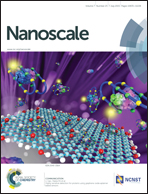In situ microfluidic SERS assay for monitoring enzymatic breakdown of organophosphates†
Abstract
In this paper, we report on a method to probe the breakdown of the organophosphate (OP) simulants o,s-diethyl methyl phosphonothioate (OSDMP) and demeton S by the enzyme organophosphorous hydrolase (OPH) in a microfluidic device by surface enhanced Raman spectroscopy (SERS). SERS hotspots were formed on-demand inside the microfluidic device by laser-induced aggregation of injected Ag NPs suspensions. The Ag NP clusters, covering micron-sized areas, were formed within minutes using a conventional confocal Raman laser microscope. These Ag NP clusters were used to enhance the Raman spectra of the thiol products of OP breakdown in the microfluidic device: ethanethiol (EtSH) and (ethylsulfanyl) ethane-1-thiol (2-EET). When the OPH enzyme and its substrates OSDMP and demeton S were introduced, the thiolated breakdown products were generated, resulting in changes in the SERS spectra. With the ability to analyze reaction volumes as low as 20 nL, our approach demonstrates great potential for miniaturization of SERS analytical protocols.


 Please wait while we load your content...
Please wait while we load your content...